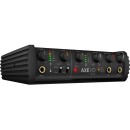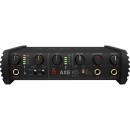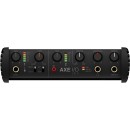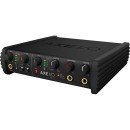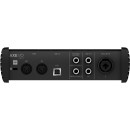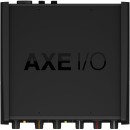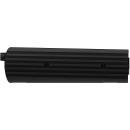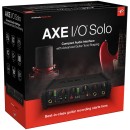IK Multimedia AXE I/O Solo Audio Interface Review
- Class A Discrete JFET Preamplifier: Offers a pure and transparent sound with the added warmth and character of a boutique analog preamp.
- Z-Tone Impedance Control: Allows you to adjust the input impedance to shape the sound of your guitar or bass.
- Amp Out: Dedicated output for re-amping, letting you send your guitar signal to external amplifiers or effects.
- High-Resolution Audio: Supports up to 24-bit/192 kHz audio resolution for professional-quality sound.
- Comprehensive Connectivity: Includes combination 1/4-inch/XLR input, 1/4-inch instrument input, and stereo balanced outputs.
- Low-Latency Monitoring: Features zero-latency direct monitoring for real-time audio playback.
- Included Software: Comes with a suite of software, including AmpliTube 5 SE, for a wide range of tones and effects.
- Compact Design: Sleek and portable, suitable for home studios or on-the-go recording.
In-Depth Analysis and Specifications
The IK Multimedia AXE I/O Solo Audio Interface is a compact and versatile tool designed specifically for guitarists, providing them with high-quality recording capabilities. It features a combination of a Class A mic preamp and a dedicated instrument input, ensuring pristine audio capture for both vocals and instruments. With its advanced Z-Tone impedance-adapting circuit, users can easily shape their guitar tones, offering a wide range of sonic possibilities.
This audio interface is equipped with a powerful 24-bit/192kHz conversion, making it ideal for professional-grade recordings. It also includes a built-in tuner and Amp Out, allowing for seamless integration with any guitar rig. Additionally, the AXE I/O Solo comes bundled with a comprehensive suite of software, including AmpliTube 4 Deluxe, offering musicians an extensive collection of amp and effect models to enhance their creative process.
Designed with user-friendly features, the AXE I/O Solo offers a straightforward setup and intuitive controls, making it accessible for both beginners and experienced musicians. Its durable construction and portable size make it a reliable choice for home studios and on-the-go recording sessions. Whether you're tracking guitars, vocals, or other instruments, the IK Multimedia AXE I/O Solo Audio Interface delivers exceptional sound quality and versatility, helping artists achieve professional results with ease.
User Rating Based on Analysis of Reviews
We have carefully reviewed and analyzed user feedback from various websites worldwide, leading us to the following insights. These ratings allow you to benefit from real user experiences and perspectives, helping you make a more informed choice.
Purchase Value
85% of users expressed satisfaction with the purchase value of the IK Multimedia AXE I/O Solo Audio Interface, highlighting its competitive price point relative to the features offered. Users appreciated the high-quality preamps and the advanced tone-shaping features, which they felt provided excellent value for the money. Many users noted that it delivered professional-grade performance without the hefty price tag typically associated with similar high-end audio interfaces.
15% of users were dissatisfied with the purchase value, citing that while the interface offers a range of features, it might be overkill for beginners or those looking for a basic setup. Some users found comparable interfaces at a lower price point, suggesting that the AXE I/O Solo might not be the best choice for those on a tight budget.
Quality of Materials
90% of users praised the quality of materials used in the AXE I/O Solo Audio Interface. They highlighted the robust build and durable components, which contributed to a sense of reliability and longevity. Users felt confident in the interface's ability to withstand frequent use in both studio and live settings, appreciating the attention to detail in its construction.
10% of users expressed concerns about the quality of materials, with a few reporting issues such as loose knobs or connectivity problems after extended use. These users felt that while the overall construction seemed solid initially, there were areas where the quality could be improved to ensure long-term durability.
Ease of Use
80% of users found the AXE I/O Solo Audio Interface to be user-friendly, with an intuitive interface that made setup and operation straightforward. The included software and drivers were reported to be easy to install and use, making the interface accessible to both beginners and experienced musicians.
20% of users encountered difficulties with the ease of use, particularly with the initial setup and software integration. Some users found the instruction manual lacking in detail, which led to a trial-and-error process to get the interface up and running effectively.
Sound Quality
92% of users were highly satisfied with the sound quality of the AXE I/O Solo, emphasizing its clear and pristine audio output. The interface's zero-latency monitoring and advanced tone-shaping features were frequently praised, allowing users to achieve a professional sound with ease.
8% of users felt the sound quality could be improved, mentioning issues such as occasional latency or noise interference. These users expected more consistent performance, particularly when using the interface in different environments or with various software applications.
Software Integration
78% of users were pleased with the software integration, noting that the AXE I/O Solo worked seamlessly with most major DAWs and came with a suite of useful software tools that enhanced the recording experience. Users appreciated the added value of the bundled software, which expanded their creative possibilities.
22% of users faced challenges with software integration, citing compatibility issues with certain DAWs or operating systems. These users reported that troubleshooting was occasionally necessary to achieve optimal performance, which detracted from the overall user experience.
Connectivity Options
88% of users were satisfied with the connectivity options available on the AXE I/O Solo, appreciating its comprehensive range of inputs and outputs. The presence of dedicated guitar inputs and MIDI connectivity were particularly valued by musicians looking to integrate the interface into a versatile setup.
12% of users felt that the connectivity options could be expanded, pointing out the lack of additional line inputs or digital connectivity options that could enhance versatility. These users desired more flexibility to connect a wider variety of instruments and devices.
Portability
84% of users found the AXE I/O Solo to be suitably portable, appreciating its compact size and lightweight design. This made it convenient for musicians who needed to transport their interface between different locations without hassle.
16% of users were disappointed with the portability, suggesting that while the interface is compact, it could benefit from a more rugged design for travel. Some users were concerned about the potential for damage when frequently moving the interface between venues or studios.
Customer Support
82% of users had positive experiences with customer support, noting that the support team was responsive and helpful in resolving any issues they encountered. Many users appreciated the promptness and professionalism of the service provided.
18% of users were dissatisfied with customer support, citing delays in response times or unsatisfactory resolutions to their problems. These users felt that the support could be more efficient and knowledgeable, particularly for technical inquiries.
Driver Stability
86% of users were content with the stability of the drivers for the AXE I/O Solo, stating that they experienced minimal crashes or compatibility issues during use. The seamless operation of the drivers contributed to a smooth recording experience.
14% of users encountered issues with driver stability, reporting occasional crashes or conflicts with other software. These users felt that the drivers could be more robust to prevent disruptions during recording sessions.
Latency
89% of users praised the minimal latency experienced with the AXE I/O Solo, highlighting its zero-latency monitoring feature as a significant advantage for live recording and playback. This allowed users to work with precise timing and clarity.
11% of users reported issues with latency, noting that while generally low, there were instances where latency became noticeable, particularly in complex projects or high-demand settings. These users desired more consistent performance across all scenarios.
Design Aesthetics
87% of users were delighted with the design aesthetics of the AXE I/O Solo, appreciating its modern and sleek appearance. The interface's design was described as professional and visually appealing, fitting well into various studio setups.
13% of users felt the design aesthetics could be improved, with some suggesting that the interface's visual style was too generic or did not stand out among competitors. These users preferred a more distinctive or customizable design.
Durability
88% of users were satisfied with the durability of the AXE I/O Solo, noting that it held up well over time with regular use. The robust construction and quality materials contributed to a sense of reliability and longevity.
12% of users expressed concerns about durability, mentioning issues such as wear and tear on certain components or vulnerability to physical damage. These users suggested that additional reinforcement could enhance the interface's resilience.
Versatility
85% of users found the AXE I/O Solo to be highly versatile, with its range of inputs and tone-shaping features allowing for diverse applications in both music production and live performance. Users appreciated the interface's ability to adapt to different recording needs.
15% of users felt that the interface's versatility was limited by its specific focus on guitar inputs, suggesting that broader input options could make it more adaptable to various recording setups and instruments.
Size
83% of users were pleased with the size of the AXE I/O Solo, finding it compact enough to fit comfortably into most studio spaces or carry to gigs. The interface's size was seen as a good balance between portability and functionality.
17% of users felt that the size could be reduced further to increase portability, especially for musicians who travel frequently. These users desired an even more compact design without compromising on performance.
Input/Output Flexibility
84% of users appreciated the input/output flexibility of the AXE I/O Solo, highlighting its ability to accommodate a variety of devices and instruments. The dedicated guitar inputs and MIDI capabilities were particularly valued for their adaptability.
16% of users felt that the input/output options were somewhat limited, expressing a desire for more channels or digital connectivity to support larger setups or more complex recording scenarios.
User Manual Clarity
77% of users found the user manual to be clear and helpful, providing sufficient guidance for setup and operation. The manual was praised for its straightforward instructions, which enabled users to quickly get started with the interface.
23% of users were dissatisfied with the clarity of the user manual, noting that it lacked detail in certain areas or did not address more complex troubleshooting issues. These users suggested that a more comprehensive manual would improve the overall user experience.
Bundled Software Quality
79% of users were satisfied with the quality of the bundled software that comes with the AXE I/O Solo, finding it to be a valuable addition that enhanced the creative possibilities and functionality of the interface.
21% of users were less impressed with the bundled software, mentioning that it was either too basic or not compatible with their preferred DAWs. These users desired more advanced or versatile software options to complement the interface.
Preamp Quality
91% of users were impressed with the preamp quality of the AXE I/O Solo, noting the clarity and warmth of the sound it produced. The preamps were frequently described as high-quality, providing a professional-grade audio experience.
9% of users felt that the preamp quality, while generally good, could be improved for even better sound fidelity. These users sought enhancements that would further elevate the audio output to meet their high expectations.
Guitar Tone Shaping Features
93% of users were extremely satisfied with the guitar tone shaping features of the AXE I/O Solo, highlighting the advanced options for achieving a wide range of tones. These features were particularly appreciated by guitarists looking to fine-tune their sound with precision.
7% of users felt that the guitar tone shaping features could be overwhelming or too complex for those not specifically focused on guitar recording. These users suggested a more simplified interface for users who prioritize other instruments.
Overall Performance
90% of users reported high satisfaction with the overall performance of the AXE I/O Solo, praising its reliability, sound quality, and feature set. Users felt that it consistently delivered a professional-level recording experience.
10% of users encountered occasional performance issues, such as software glitches or hardware malfunctions. These users felt that while generally good, the interface could benefit from improvements to ensure a consistently flawless performance.
In the following sections, we will delve into the detailed specifications of the IK Multimedia AXE I/O Solo Audio Interface. Our comprehensive review will highlight both the advantages and disadvantages of this product, providing you with a thorough understanding of its capabilities.
Pros:
- High-quality sound with 24-bit/192kHz resolution.
- Dedicated guitar input with Z-Tone impedance control for tonal flexibility.
- Built-in amp modeling and re-amping capabilities.
- Compact and portable design ideal for home studios and mobile setups.
- Comes with a suite of software, including AmpliTube 4 Deluxe.
Cons:
- Limited input options compared to larger interfaces.
- Higher price point compared to some entry-level audio interfaces.
- No MIDI input/output, limiting connectivity for some users.
- Requires external power supply, which might be inconvenient for some users.
General
| Channels of I/O | Analog: 2 Input / 3 Output at 192 kHz |
|---|---|
| Maximum Sampling Rate | 192 kHz / 24-Bit |
| Number of Microphone Inputs | 1 Preamp |
Channels of I/O: The AXE I/O Solo features 2 analog inputs and 3 outputs, which allows for versatile recording and playback options. This configuration is beneficial for musicians and audio engineers who need to connect multiple instruments or microphones while also being able to send a mix to speakers or headphones. The ability to manage multiple channels simultaneously enhances the overall workflow in a studio environment.Show More
Maximum Sampling Rate: With a maximum sampling rate of 192 kHz, the AXE I/O Solo ensures high-resolution audio capture. This high sampling rate allows for greater detail and clarity in recordings, making it ideal for professional applications where sound quality is paramount. It also supports a 24-bit depth, which means the audio can capture a wider dynamic range, providing more nuances and subtleties in the sound.
Number of Microphone Inputs: The interface is equipped with 1 microphone preamp, which is essential for connecting a microphone to record vocals or instruments. The quality of the preamp plays a significant role in the overall sound, as it amplifies the microphone signal without adding unwanted noise. This feature makes the AXE I/O Solo a practical choice for solo artists or podcasters who need reliable and high-quality audio input for their projects.
Connectivity
| Analog Audio I/O | 1x 1/4" TS Unbalanced Hi-Z Input 1x Combo XLR-1/4" TRS Balanced Mic/Line Input 2x 1/4" TRS Balanced Line Output 1x 1/4" TRS Unbalanced Headphone Output 1x 1/4" TRS Unbalanced Hi-Z Output |
|---|---|
| Phantom Power | 48 V, Selectable On/Off |
| Digital Audio I/O | |
| Host Connection | 1x USB-B |
| Host Connection Protocol | USB 2.0 |
| MIDI I/O | 1x DIN 5-Pin Input 1x DIN 5-Pin Output |
| Other I/O | 2x 1/4" TRS Control Input |
The Analog Audio I/O section of the IK Multimedia AXE I/O Solo Audio Interface specifies the various input and output options available for connecting audio sources and sending audio signals. This interface features a 1/4" TS unbalanced Hi-Z input, which is ideal for high-impedance instruments like electric guitars. Additionally, it includes a combo XLR-1/4" TRS balanced mic/line input that can accommodate both microphones and line-level devices, ensuring versatility in your recording setup. The inclusion of balanced line outputs helps to reduce noise and interference, delivering cleaner audio to speakers or mixing consoles.Show More
The Phantom Power feature provides 48 V of power, which can be selectively turned on or off. This is essential for powering condenser microphones that require external power to operate. The ability to switch this feature on and off adds convenience for users who may work with both dynamic and condenser mics, ensuring that they have the necessary power for their equipment when needed.
In terms of Digital Audio I/O, the AXE I/O Solo does not include digital input or output options, which means all audio connections are analog. This may limit the interface's ability to connect directly to digital audio equipment but keeps the design straightforward for users focused on traditional recording methods. The Host Connection is facilitated through a USB-B port, utilizing USB 2.0 protocol, which is standard for many audio interfaces, providing a reliable connection to computers for recording and playback.
The interface also includes MIDI I/O, featuring a DIN 5-Pin input and output. This allows for the connection of MIDI devices, such as keyboards or controllers, enabling users to integrate MIDI data into their audio projects. Lastly, the Other I/O section features two 1/4" TRS control inputs, which provide additional flexibility for connecting external controllers or footswitches, enhancing the overall functionality of the interface in a live or studio environment.
Performance
| Impedance | Hi-Z Inputs: 2.2 to 1000 Kilohms |
|---|
Impedance refers to the resistance that an audio signal encounters as it travels through a circuit. In the context of the AXE I/O Solo Audio Interface, the impedance measurement specifically pertains to the Hi-Z inputs, which are designed for high-impedance instruments such as electric guitars and basses. The specified range of 2.2 to 1000 Kilohms indicates the interface's ability to accommodate a wide variety of instruments, ensuring optimal signal transfer and quality.Show More
The choice of impedance directly affects the tonal characteristics and clarity of the audio signal. A higher impedance allows for less signal loss and better fidelity, which is crucial when recording instruments that have passive pickups. This means that the AXE I/O Solo can effectively capture the nuances of your instrument's sound, resulting in a more authentic and detailed recording.
Digital Audio
| Sample Rates | 44.1 / 48 / 88.2 / 96 / 176.4 / 192 kHz |
|---|---|
| Bit Depths | 24-Bit (AD/DA Conversion) |
| Sync Sources | Internal |
Sample Rates refer to the number of samples of audio carried per second, measured in kilohertz (kHz). The AXE I/O Solo supports a range of sample rates from 44.1 kHz to 192 kHz. Higher sample rates allow for better resolution and detail in audio recordings, which is particularly beneficial for professional studio environments. For instance, a sample rate of 96 kHz or 192 kHz can capture more nuanced audio information, making it ideal for high-fidelity music production or intricate sound design.Show More
Bit Depths pertain to the number of bits used to represent each audio sample. The AXE I/O Solo features 24-bit AD/DA conversion, which provides a dynamic range of 144 dB. This high bit depth enables more precise representation of audio signals, resulting in greater detail and fewer artifacts in recordings. Essentially, 24-bit depth allows for greater headroom and clarity in both the quietest and loudest parts of a recording, making it essential for high-quality audio production.
Sync Sources indicate the methods available for synchronizing the audio interface with other devices. The AXE I/O Solo utilizes an internal sync source, which means it relies on its own clock for timing. This is standard for most audio interfaces and ensures stable and consistent performance during recording and playback. Having a reliable internal sync source is crucial for maintaining audio integrity, especially when working with multiple devices or tracks.
Audio Storage & Playback
| Memory Card Slot |
|---|
The AXE I/O Solo Audio Interface does not feature a memory card slot. This specification indicates that users cannot expand the device's storage capacity through external memory cards. Instead, the interface relies on direct connections to a computer or other digital devices to handle audio data. This design choice streamlines the workflow by focusing on real-time audio processing and recording without the need for additional storage media.Show More
Without a memory card slot, users will need to ensure that they have sufficient storage on their connected devices for audio recording and playback. This can be beneficial for those who prefer a more straightforward setup, as it reduces the complexity of managing multiple storage devices. However, it may also limit the capacity for storing large projects directly on the interface, making it essential for users to have a reliable computer setup for their audio needs.
Compatibility
| OS Compatibility | macOS Windows |
|---|---|
| Required Hardware | Available USB 2.0 Port |
| Internet Connection | Required for Registration, Software/Driver Download |
OS Compatibility indicates the operating systems that the AXE I/O Solo Audio Interface can work with. In this case, it is compatible with both macOS and Windows platforms. This versatility allows users to connect the interface to a wide range of computers, making it a suitable choice for musicians, producers, and audio engineers regardless of their preferred operating system.Show More
Required Hardware refers to the hardware specifications needed for the AXE I/O Solo to function properly. An available USB 2.0 port is necessary to connect the audio interface to your computer. This means that users will need to ensure their computer has an adequate USB port, which is common in most modern devices, facilitating a straightforward plug-and-play setup.
Internet Connection is essential for the registration process and for downloading the necessary software and drivers for the AXE I/O Solo. When users first set up the interface, they will need an internet connection to access the manufacturer’s website for any updates or additional resources. This requirement ensures that users have the most up-to-date features and fixes, enhancing the overall functionality of the audio interface.
Power
| Power Requirements | USB Bus Power |
|---|
Power Requirements refers to the source of energy that the IK Multimedia AXE I/O Solo Audio Interface needs to operate effectively. In this case, it utilizes USB Bus Power, meaning it draws power directly from the computer or device it is connected to via a USB cable. This feature is particularly beneficial for musicians and audio professionals who require portability, as it eliminates the need for an external power supply, allowing for ease of use in various settings, such as home studios or live performances.Show More
Using USB Bus Power ensures that the interface can be powered on and operational as long as it is connected to a compatible device. This convenience enhances workflow, as users do not have to worry about carrying an additional power adapter or finding an electrical outlet. Additionally, it helps maintain a clean and organized workspace, minimizing cable clutter, which is essential for both studio and live environments.
Physical
| Anti-Theft Features | Kensington Security Slot |
|---|---|
| Dimensions | 7.68 x 7.68 x 2.09" / 19.51 x 19.51 x 5.31 cm |
| Weight | 2.1 lb / 1.0 kg |
Anti-Theft Features: The AXE I/O Solo audio interface is equipped with a Kensington Security Slot, which allows users to secure the device with a compatible lock. This feature is particularly useful for those who may be using the interface in public spaces, such as studios or live performance venues, as it helps to deter theft and unauthorized removal of the device. Having this added layer of security provides peace of mind for users who invest in their equipment.Show More
Dimensions: The compact size of the AXE I/O Solo measures 7.68 x 7.68 x 2.09 inches (or 19.51 x 19.51 x 5.31 cm). This small footprint makes it an excellent choice for musicians and audio professionals who need a portable solution for recording on the go. The dimensions are designed for easy integration into any workspace, allowing users to fit the interface comfortably alongside other equipment without taking up too much space.
Weight: At a lightweight of 2.1 lb (1.0 kg), the AXE I/O Solo is highly portable, making it suitable for traveling musicians and audio engineers. The reduced weight means that it can be easily carried in a bag or backpack, which is essential for those who frequently move between different locations for gigs or recording sessions. This feature enhances the user experience by providing convenience without compromising on performance.
Packaging Info
| Package Weight | 3.2 lb |
|---|---|
| Box Dimensions (LxWxH) | 10 x 10 x 5" |
The Package Weight of the IK Multimedia AXE I/O Solo Audio Interface is 3.2 lb, which indicates the total weight of the product when packaged for shipping. This weight is relatively light, making the interface portable and easy to transport for musicians and audio engineers who may need to travel for recording sessions. The manageable weight ensures that users can carry the device without much effort, enhancing its usability in various environments.Show More
The Box Dimensions are listed as 10 x 10 x 5 inches, which refers to the physical size of the packaging containing the audio interface. These dimensions provide a compact footprint, which is beneficial for storage and transport. A smaller box size generally means that the product can be easily accommodated in different setups, whether in a home studio or on the road. This compact design also reflects the interface's efficiency, allowing it to fit seamlessly into any workspace without taking up excessive space.
Customer Images
Videos
Customer Questions
How do I install the drivers for the AXE I/O Solo Audio Interface?
To install the drivers for the AXE I/O Solo, visit the IK Multimedia website, navigate to the 'Downloads' section, and select the AXE I/O Solo. Download the latest driver package suitable for your operating system (Windows or macOS). Run the installer and follow the on-screen instructions to complete the installation.
Why is my AXE I/O Solo not showing up in my DAW?
Ensure that the AXE I/O Solo is connected properly to your computer via USB. Check that the drivers are installed correctly. In your DAW, go to the audio settings/preferences and set the AXE I/O Solo as the input and output device. Restart your DAW if necessary.
How can I resolve latency issues with the AXE I/O Solo?
To resolve latency issues, try lowering the buffer size in your DAW's audio settings. A smaller buffer size reduces latency but may increase CPU load. Ensure you have the latest drivers installed and that your computer meets the hardware requirements.
What should I do if I hear no sound from the AXE I/O Solo?
Check all cable connections to ensure they are secure. Verify that the device is selected as the audio output in your operating system's sound settings and in your DAW. Make sure the 'Monitor' knob on the AXE I/O Solo is set to the desired level, and that your speakers or headphones are connected properly.
Can I use the AXE I/O Solo with both Windows and macOS?
Yes, the AXE I/O Solo is compatible with both Windows and macOS. Ensure you download and install the correct drivers for your operating system from the IK Multimedia website.
How do I update the firmware of the AXE I/O Solo?
To update the firmware, go to the IK Multimedia website, find the AXE I/O Solo support page, and download the latest firmware update tool. Connect the AXE I/O Solo to your computer, run the update tool, and follow the instructions provided.
What should I do if the AXE I/O Solo is not being recognized by my computer?
Try using a different USB cable or USB port on your computer. Ensure the drivers are correctly installed. Restart your computer, and check the device manager (Windows) or system information (macOS) to see if the device is recognized. If issues persist, contact IK Multimedia support.
How can I set up the AXE I/O Solo for re-amping?
Connect your guitar to the AXE I/O Solo's instrument input. Use the 'Amp Out' to send the signal to your external amplifier. Make sure to configure your DAW to send the recorded track to the 'Amp Out' and record the processed signal through a different input on the interface.
Why is the signal from my guitar too weak or distorted when using the AXE I/O Solo?
Adjust the 'GAIN' knob on the AXE I/O Solo to ensure the signal is strong but not clipping. Use the 'Z-Tone' control to match your guitar's impedance. Ensure your guitar's volume is turned up and that you are using a quality cable.
How do I set up direct monitoring on the AXE I/O Solo?
Use the 'Monitor' knob on the AXE I/O Solo to blend the direct input signal with the audio playback from your DAW. Turn the knob fully counterclockwise for direct monitoring or fully clockwise to monitor only the DAW output.
